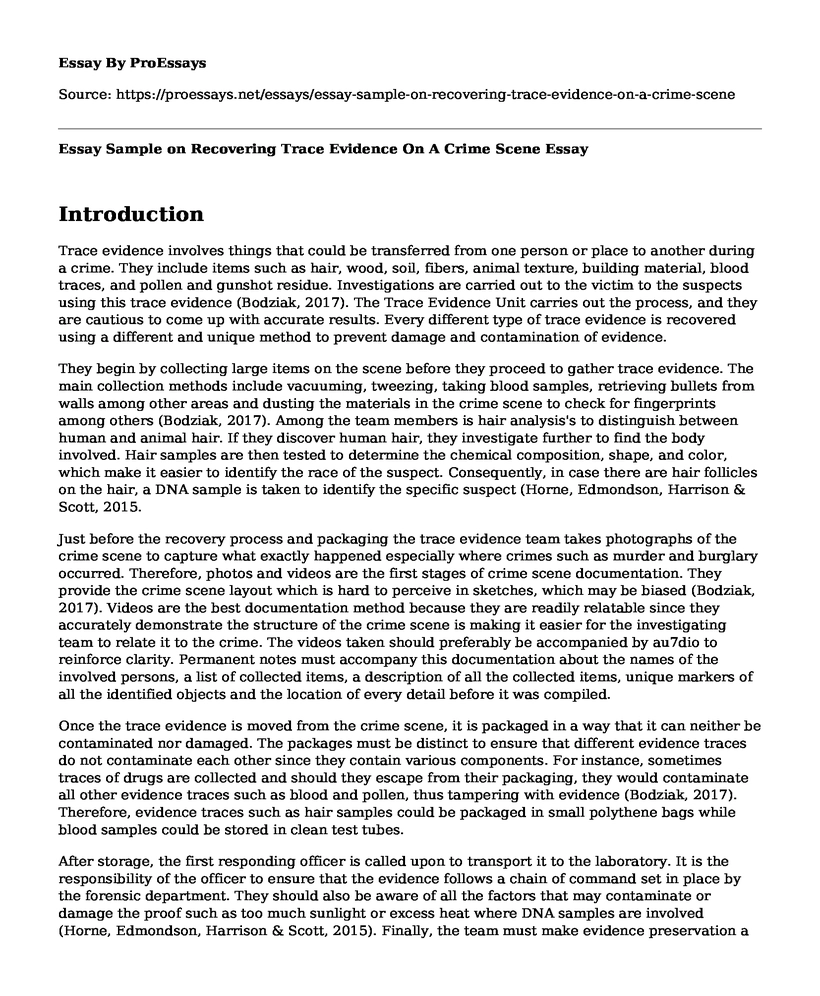Introduction
Trace evidence involves things that could be transferred from one person or place to another during a crime. They include items such as hair, wood, soil, fibers, animal texture, building material, blood traces, and pollen and gunshot residue. Investigations are carried out to the victim to the suspects using this trace evidence (Bodziak, 2017). The Trace Evidence Unit carries out the process, and they are cautious to come up with accurate results. Every different type of trace evidence is recovered using a different and unique method to prevent damage and contamination of evidence.
They begin by collecting large items on the scene before they proceed to gather trace evidence. The main collection methods include vacuuming, tweezing, taking blood samples, retrieving bullets from walls among other areas and dusting the materials in the crime scene to check for fingerprints among others (Bodziak, 2017). Among the team members is hair analysis's to distinguish between human and animal hair. If they discover human hair, they investigate further to find the body involved. Hair samples are then tested to determine the chemical composition, shape, and color, which make it easier to identify the race of the suspect. Consequently, in case there are hair follicles on the hair, a DNA sample is taken to identify the specific suspect (Horne, Edmondson, Harrison & Scott, 2015.
Just before the recovery process and packaging the trace evidence team takes photographs of the crime scene to capture what exactly happened especially where crimes such as murder and burglary occurred. Therefore, photos and videos are the first stages of crime scene documentation. They provide the crime scene layout which is hard to perceive in sketches, which may be biased (Bodziak, 2017). Videos are the best documentation method because they are readily relatable since they accurately demonstrate the structure of the crime scene is making it easier for the investigating team to relate it to the crime. The videos taken should preferably be accompanied by au7dio to reinforce clarity. Permanent notes must accompany this documentation about the names of the involved persons, a list of collected items, a description of all the collected items, unique markers of all the identified objects and the location of every detail before it was compiled.
Once the trace evidence is moved from the crime scene, it is packaged in a way that it can neither be contaminated nor damaged. The packages must be distinct to ensure that different evidence traces do not contaminate each other since they contain various components. For instance, sometimes traces of drugs are collected and should they escape from their packaging, they would contaminate all other evidence traces such as blood and pollen, thus tampering with evidence (Bodziak, 2017). Therefore, evidence traces such as hair samples could be packaged in small polythene bags while blood samples could be stored in clean test tubes.
After storage, the first responding officer is called upon to transport it to the laboratory. It is the responsibility of the officer to ensure that the evidence follows a chain of command set in place by the forensic department. They should also be aware of all the factors that may contaminate or damage the proof such as too much sunlight or excess heat where DNA samples are involved (Horne, Edmondson, Harrison & Scott, 2015). Finally, the team must make evidence preservation a top priority to avoid destruction or contamination. If evidence is not well preserved before forensic testing, it may devalue the source of information. Different trace evidence should be maintained using the right preservatives. For instance, while blood and DNA samples are preserved under low temperatures, others such as hair can withstand any rate of heat.
References
Bodziak, W. J. (2017). Footwear impression evidence: detection, recovery, and examination. CRC Press.
Horne, N., Edmondson, K., Harrison, M., & Scott, B. (2015). The applied use of forensic intelligence for the community and organized crime. Australian Journal of Forensic Sciences,47(1), 72-82.
Cite this page
Essay Sample on Recovering Trace Evidence On A Crime Scene. (2022, Jul 11). Retrieved from https://proessays.net/essays/essay-sample-on-recovering-trace-evidence-on-a-crime-scene
If you are the original author of this essay and no longer wish to have it published on the ProEssays website, please click below to request its removal:
- Cases Overview Examples
- Forensic Anthropology: Case Study
- Story of Evil Criminology Essay Example
- Research Paper on Rising Healthcare Costs in Prisons: Elderly, Poor, Women, Mental Health
- Deviance and Criminology: Understanding the Impact of Social Norms - Essay Sample
- Justice System & Correctional Facilities: A Broken Promise? - Essay Sample
- The Notorious Serial Killer Ted Bundy: 30 Confirmed Murders and Beyond - Essay Sample







